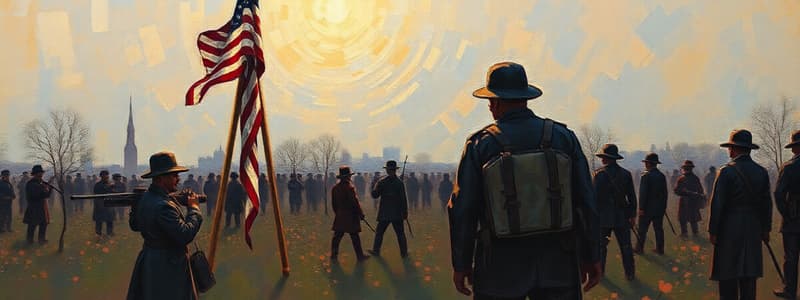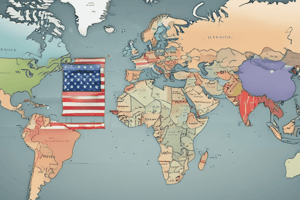Podcast
Questions and Answers
What was the primary hope of President Woodrow Wilson regarding World War I?
What was the primary hope of President Woodrow Wilson regarding World War I?
- To create the League of Nations
- To establish economic treaties with Europe
- To reduce American military involvement in Europe
- To make it the 'war to end all wars' (correct)
What was the general atmosphere in the United States during the 1920s and 1930s regarding involvement in foreign conflicts?
What was the general atmosphere in the United States during the 1920s and 1930s regarding involvement in foreign conflicts?
- An isolationist sentiment among the populace (correct)
- Strong support for international alliances
- A commitment to collective security
- Enthusiasm for colonial expansion
Which agreement was signed in 1928 that declared war an international crime?
Which agreement was signed in 1928 that declared war an international crime?
- The Kellogg-Briand Pact (correct)
- The Treaty of Versailles
- The Four Power Treaty
- The League of Nations Covenant
What did the Four Power Treaty commit its signatories to refrain from?
What did the Four Power Treaty commit its signatories to refrain from?
During the lead-up to World War II, which of the following was a significant focus for the United States?
During the lead-up to World War II, which of the following was a significant focus for the United States?
What was a significant factor that allowed Mussolini to rise to power in Italy?
What was a significant factor that allowed Mussolini to rise to power in Italy?
Which event marked the beginning of Adolf Hitler's consolidation of power?
Which event marked the beginning of Adolf Hitler's consolidation of power?
What was a consequence of the economic depression in Europe during the 1920s?
What was a consequence of the economic depression in Europe during the 1920s?
What was one of the main tenets of Fascism as promoted by Mussolini?
What was one of the main tenets of Fascism as promoted by Mussolini?
What was a major flaw in the agreements signed by nations in the years leading to World War II?
What was a major flaw in the agreements signed by nations in the years leading to World War II?
What was the primary motivation behind Stalin's decision to make an agreement with Hitler in 1939?
What was the primary motivation behind Stalin's decision to make an agreement with Hitler in 1939?
Which act specifically prohibited American citizens from traveling on ships of nations at war?
Which act specifically prohibited American citizens from traveling on ships of nations at war?
What was the significance of the Anti-Comintern Pact signed by Japan and Germany in 1936?
What was the significance of the Anti-Comintern Pact signed by Japan and Germany in 1936?
How did American public sentiment change in response to Japanese aggression in China?
How did American public sentiment change in response to Japanese aggression in China?
What was President Roosevelt's approach to assisting victims of Nazi persecution during the late 1930s?
What was President Roosevelt's approach to assisting victims of Nazi persecution during the late 1930s?
What was the primary military strategy employed by Germany during its invasion of Poland in 1939?
What was the primary military strategy employed by Germany during its invasion of Poland in 1939?
Which Act allowed the United States to sell and lease military equipment to nations important to its defense?
Which Act allowed the United States to sell and lease military equipment to nations important to its defense?
What was a significant consequence of the Japanese attack on Pearl Harbor?
What was a significant consequence of the Japanese attack on Pearl Harbor?
What was one of the main promises of the Atlantic Charter agreed upon by Roosevelt and Churchill?
What was one of the main promises of the Atlantic Charter agreed upon by Roosevelt and Churchill?
Which of the following statements correctly describes the early actions of the United States in World War II before entering the conflict?
Which of the following statements correctly describes the early actions of the United States in World War II before entering the conflict?
What was one of the major reasons that led to the significant increase in corporate profits during the war effort?
What was one of the major reasons that led to the significant increase in corporate profits during the war effort?
How many men were estimated to be needed for military service to secure victory in World War II?
How many men were estimated to be needed for military service to secure victory in World War II?
Which of the following statements is correct regarding the treatment of African American soldiers during the early years of World War II?
Which of the following statements is correct regarding the treatment of African American soldiers during the early years of World War II?
What event caused a surge in American public sentiment towards engaging in World War II?
What event caused a surge in American public sentiment towards engaging in World War II?
Which policy was enacted by Congress in response to the increasing need for military personnel before the onset of World War II?
Which policy was enacted by Congress in response to the increasing need for military personnel before the onset of World War II?
Flashcards
US Isolationism (1920s-1930s)
US Isolationism (1920s-1930s)
The prevailing American foreign policy of avoiding significant involvement in global affairs, particularly in Europe, during the 1920s and 1930s. It prioritized national interests and a desire to avoid another large-scale war.
Treaty of Versailles
Treaty of Versailles
A peace treaty that ended World War 1, imposing harsh penalties on Germany, and contributing to the political instability in Europe. It redrew the map of Europe.
Kellogg-Briand Pact
Kellogg-Briand Pact
An agreement signed by the US and other nations that officially condemned war as a means of international conflict resolution.
Washington Naval Conference
Washington Naval Conference
Signup and view all the flashcards
Collective Security
Collective Security
Signup and view all the flashcards
Great Depression impact on Europe
Great Depression impact on Europe
Signup and view all the flashcards
Rise of Fascism in Italy
Rise of Fascism in Italy
Signup and view all the flashcards
Nazi rise to power in Germany
Nazi rise to power in Germany
Signup and view all the flashcards
Appeasement policy (Munich Pact)
Appeasement policy (Munich Pact)
Signup and view all the flashcards
Totalitarianism
Totalitarianism
Signup and view all the flashcards
Soviet-German Non-Aggression Pact
Soviet-German Non-Aggression Pact
Signup and view all the flashcards
Japanese Militarism
Japanese Militarism
Signup and view all the flashcards
Anti-Comintern Pact
Anti-Comintern Pact
Signup and view all the flashcards
US Neutrality Acts
US Neutrality Acts
Signup and view all the flashcards
Roosevelt's Limited Support for War Victims
Roosevelt's Limited Support for War Victims
Signup and view all the flashcards
Munich Conference Failure
Munich Conference Failure
Signup and view all the flashcards
Pact of Steel
Pact of Steel
Signup and view all the flashcards
Blitzkrieg
Blitzkrieg
Signup and view all the flashcards
Cash and Carry
Cash and Carry
Signup and view all the flashcards
Lend-Lease
Lend-Lease
Signup and view all the flashcards
Pearl Harbor Attack
Pearl Harbor Attack
Signup and view all the flashcards
US War Production
US War Production
Signup and view all the flashcards
Impact of War on Businesses
Impact of War on Businesses
Signup and view all the flashcards
Expansion of Military
Expansion of Military
Signup and view all the flashcards
African American Soldiers
African American Soldiers
Signup and view all the flashcards




